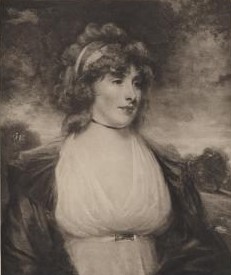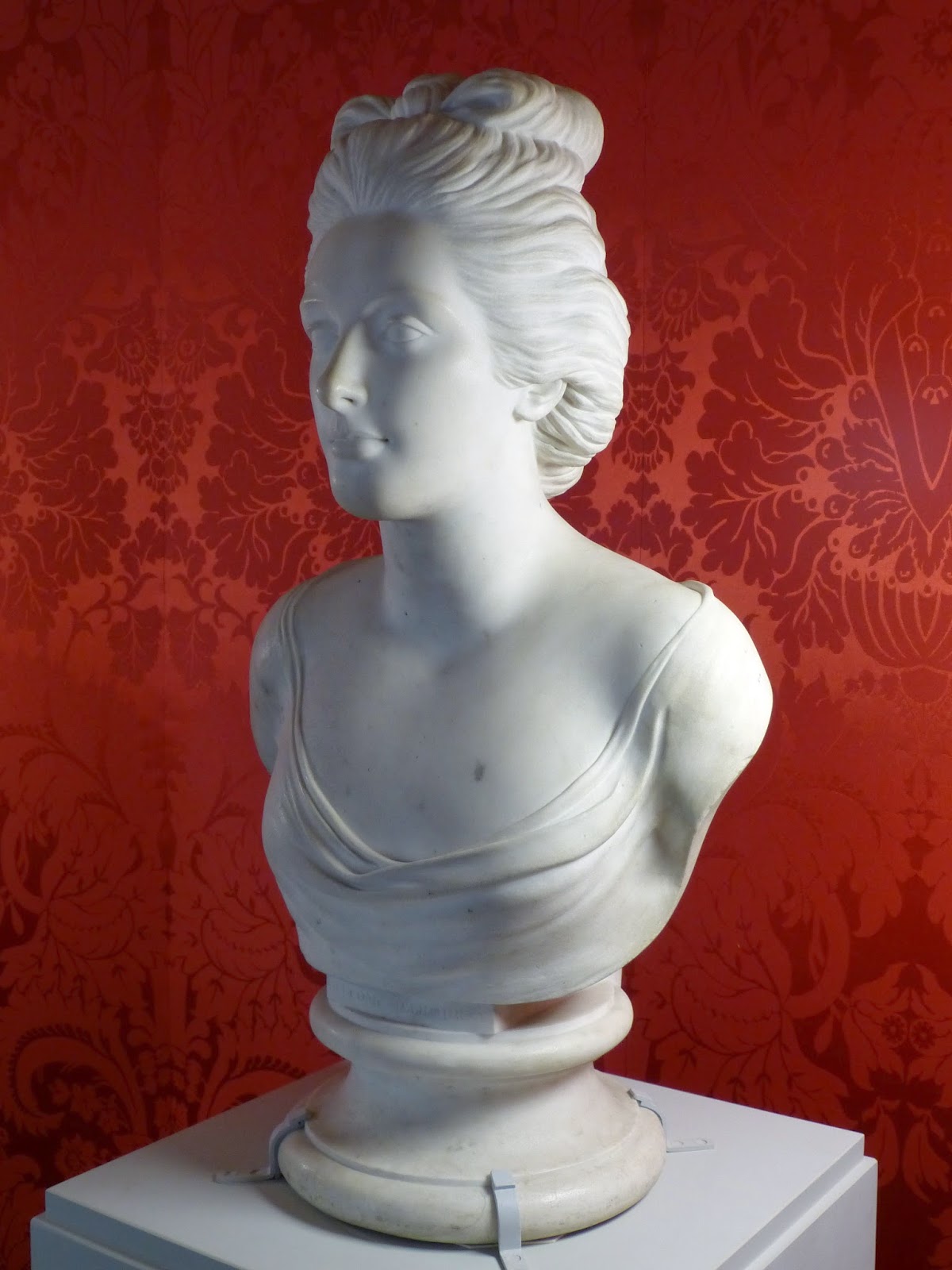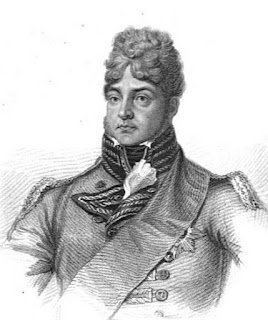 |
| Elizabeth Lamb, Viscountess Melbourne from The Three Witches from Macbeth by Daniel Gardner (1775) © National Portrait Gallery |
Lady Melbourne (baptised 15 October 1751 - 6 April 1818) was a leading Whig hostess, the intimate friend of Georgiana, Duchess of Devonshire and Lord Byron, a mistress of George IV and the mother of the Prime Minister, William Lamb, Viscount Melbourne, and his sister Emily, Lady Cowper, one of the patronesses of Almack's Assembly Rooms.
Family life
Elizabeth Milbanke was baptised on 15 October 1751, the only daughter of Sir Ralph Milbanke, a Yorkshire landowner and politician, and his wife, Elizabeth Hedworth. She married Sir Peniston Lamb, 2nd Baronet, a wealthy Whig politician, on 13 April 1769, at the age of seventeen.
Sir Peniston was made an Irish peer, Lord Melbourne, Baron of Kilmore, on 8 June 1770, and then Viscount Melbourne on 11 January 1781. Later, in 1815, he was made a peer of the United Kingdom, Baron Melbourne of Melbourne.
 |
Elizabeth Lamb, Viscountess Melbourne
by Braun, Clement & Co, after John Hoppner
© National Portrait Gallery, London
|
Elizabeth was beautiful and vibrant and ambitious for the advancement of her family. She helped increase her husband’s political visibility, becoming the leading Whig hostess of the time. From 1770, she entertained in the white and gold magnificence of Melbourne House in Piccadilly, designed by William Chambers. Her regular visitors included some of the keenest minds of the day: Charles James Fox; Richard Brinsley Sheridan; Granville Leveson-Gower, 1st Earl Granville; Georgiana Cavendish, Duchess of Devonshire; Harriet Ponsonby, Countess of Bessborough; and the sculptor, Anne Seymour Damer.
 |
| Lady Melbourne by Anne Seymour Damer (1784) in an exhibition at Strawberry Hill |
In 1774, the Duke of Devonshire married Georgiana Spencer and Lady Melbourne saw at once that she was in danger of losing her place as leading Whig hostess. But rather than compete with the Duchess, Lady Melbourne chose to embrace her potential rival and became her indispensable friend. They were opposites in character and temperament, but Lady Melbourne’s disposition made her the ideal confidante for the troubled Duchess.
 |
Georgiana, Duchess of Devonshire,
from a miniature by Antonio Fattori
from Lord Granville Leveson Gower,
private correspondence 1781 to 1821 (1916)
|
Lady Melbourne was a brilliant conversationalist who was a master of the art of being a delightful companion to gentlemen. She was easy going and good humoured, a willing confidante and advisor who rarely talked about herself. Melbourne House was a comfortable place for gentlemen to go, where they could speak freely without fear of shocking their hostess.
On the other hand, she was cynical, hard-hearted and somewhat coarse, and she seemed to delight in making cutting remarks. Her moral standards were low and she did not seem to care what people did, provided they were discreet. She believed that:
When anyone braves the opinion of the world, sooner or later they will feel the consequences of it.1
Ambition was paramount and she was always prepared to make sacrifices to achieve it. When Frederick, Duke of York expressed a fancy for her Piccadilly home, she agreed to part-exchange it for his home in Whitehall. 2
 |
Melbourne House, Piccadilly,
by Thomas H. Shepherd c1830 |
Lady Melbourne had six children: Peniston (1770), William (1779), Frederick (1782), George (1784), Emily (1787) and Harriet (1789), who did not survive childhood. Of these, only Peniston was definitely Lord Melbourne’s child; William was almost certainly Lord Egremont’s and George, the son of the Prince of Wales.
She was devoted to all her children who spent most of their time at the family’s country home in Hertfordshire, Brocket Hall. Here they rode and played together and took part in theatricals as well as learning. When the boys went to Eton, she often visited them, encouraging the development of their tastes and characters.
 |
| William Lamb, 2nd Viscount Melbourne from The History of White's by Hon Algernon Bourke (1892) |
Within a year of their marriage, Elizabeth’s husband began an affair with the actress Sophia Baddeley. Elizabeth appeared to be unbothered. She did not expect men to be monogamous, though she strongly believed in family responsibility. Having produced an heir, she had her own romantic liaisons, though she made sure she never put her husband in an awkward position.
Lady Melbourne’s name was linked variously with Lord Coleraine3; Francis Russell, 5th Duke of Bedford; George, Prince of Wales, the future George IV; and George Wyndham, 3rd Earl of Egremont.
The Earl of Egremont
From 1779, Lady Melbourne’s most favoured intimate friend and advisor was George Wyndham, 3rd Earl of Egremont. It was the most serious and long-lasting of her attachments, though not monogamous on either side; Egremont kept a number of mistresses and their children at Petworth House. Egremont was almost certainly William’s father and possibly Frederick and Emily’s as well.
Lady Melbourne learned much from Egremont who was an agriculturalist and canal enthusiast. She encouraged her husband to invest in the Cromford Canal and introduced agricultural innovations in Hertfordshire.
 |
| George Wyndham, 3rd Earl of Egremont by Samuel William Reynolds, after Thomas Phillips (1826) © National Portrait Gallery, London |
Lady Melbourne’s friendship with the Prince of Wales began in 1782 and their names were linked together until around 1786. He is generally believed to be the father of her fourth son, George, and stood as his godfather.
Through her relationship with the Prince, Lady Melbourne secured the position of Gentleman of the Bedchamber for her husband in 1783.
 |
| George, Prince of Wales from Huish's Memoirs of her late royal highness Charlotte Augusta (1818) |
Lady Melbourne soon realised that William’s abilities were superior to those of his siblings and he became the focus for all her ambitions. After the death of her eldest son, Peniston, in 1805, William embarked on a career in politics. He also married Lady Bessborough’s daughter, Lady Caroline Ponsonby. Lady Melbourne was not keen on the match or the influence that Caro and her mother had on William. On her side, Lady Bessborough disliked Lady Melbourne and referred to her as “The Thorn”.
 |
| Lady Caroline Lamb from Wives of the Prime Ministers (1844-1906) |
It was with some frustration that Lady Melbourne saw William failing to reach the heights which she sought for him. He was hedonistic and lazy, loyal to people rather than policies, and did not advance as she had hoped, and his deteriorating relationship with Caroline was not helping.
Lady Melbourne had no sympathy with Lady Caroline’s highly strung nature and was disgusted when, in 1812, she had a very public affair with Lord Byron. Lady Melbourne was keen to bring it to a close and became Lord Byron’s confidante, suggesting her own niece, Annabella Milbanke, as a wife for him.
Illness and death
Lady Melbourne became ill with rheumatism and died at Melbourne House, Whitehall, on 6 April 1818, after a painful illness of four months. She was buried on 14 April in Hatfield, Hertfordshire. Even on her death bed, she encouraged her children’s ambitions, telling Emily to be faithful, not to her husband, Lord Cowper, but to her lover, Lord Palmerston.
Lady Melbourne's legacy
Lady Melbourne did not live to see that her ambitions for her children were indeed fulfilled: William became Prime Minister to William IV and then Queen Victoria, and Emily married Lord Palmerston, who later became another of Queen Victoria’s Prime Ministers.
Rachel Knowles writes clean/Christian Regency era romance and historical non-fiction. She has been sharing her research on this blog since 2011. Rachel lives in the beautiful Georgian seaside town of Weymouth, Dorset, on the south coast of England, with her husband, Andrew.
Find out more about Rachel's books and sign up for her newsletter here.If you have enjoyed this blog and want to encourage me and help me to keep making my research freely available, please buy me a virtual cup of coffee by clicking the button below.
Notes
(1) From a letter to Lady Caroline Lamb 13 April 1810.
(2) The agreement to the exchange was concluded on 25 December 1791 although the comment made by the Duke of York to which Lady Melbourne assented may have been made some time before. The Duke took residence of Melbourne House the following year, renaming it Albany House.
(3) The relationship with Lord Coleraine is referred to in Cecil's book Melbourne. Based on the dates quoted, I am assuming that it is John Hanger, 2nd Baron Coleraine, with whom Lady Melbourne had an affair.
(3) The relationship with Lord Coleraine is referred to in Cecil's book Melbourne. Based on the dates quoted, I am assuming that it is John Hanger, 2nd Baron Coleraine, with whom Lady Melbourne had an affair.
Sources used include:
Cecil, Lord David, Melbourne (1939, 1954)
Gross, Jonathan David, Lamb, Elizabeth, Viscountess Melbourne (1751-1818) Oxford Dictionary of National Biography (Oxford University Press, 2004; online edn May 2008, accessed 12 Nov 2012)
Huish, Robert, Memoirs of her late royal highness Charlotte Augusta (1818)
Lee, Elizabeth, Wives of the Prime Ministers 1844-1906 (1918)
Leveson-Gower, Lord Granville, Lord Granville Leveson-Gower, Private correspondence 1781-1821, ed by Castalia, Countess Granville (John Murray, 1916, London)
Shepherd, FHW, Survey of London (1963, British History online, accessed 7 February 2013)
Photographs © RegencyHistory.net


No comments:
New comments are not allowed.